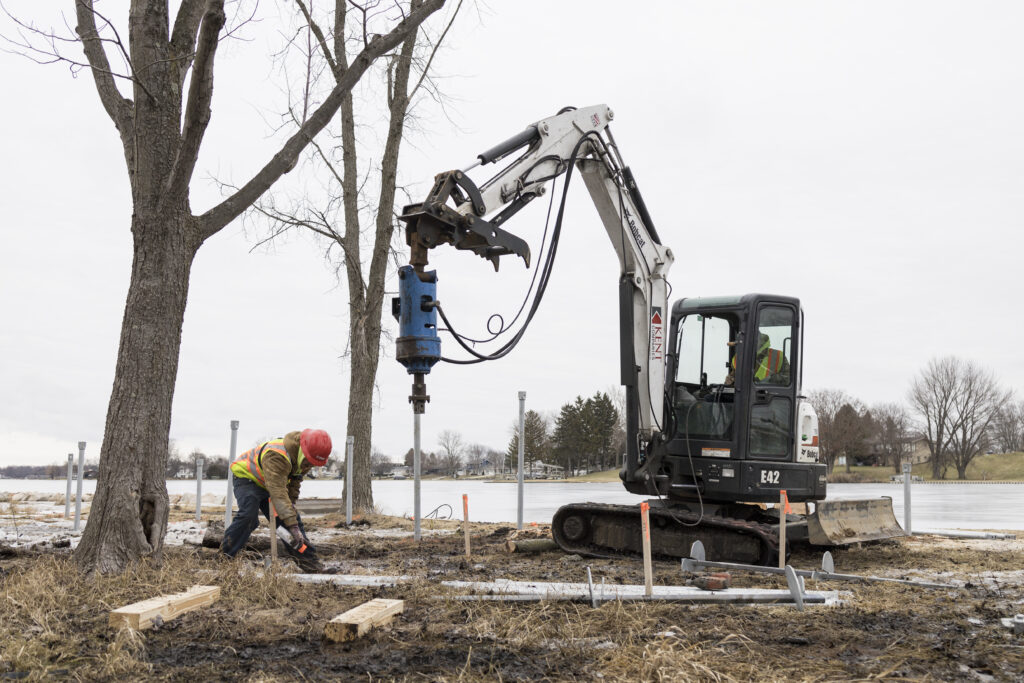What Are Resistance Push Piers?

Contractors have been battling sinking foundations for hundreds of years, and it’s not always easy. It takes a solid solution to prevent a settling foundation from causing further damage to a structure. But with a wide range of options, it can be hard to determine which is right for a specific situation. Weighing the pros and cons of potential solutions, such as helical piers vs. push piers, will reveal which repair is right for you.
Contractors have used resistance push piers in commercial and home construction since the 1900s, and they still offer highly effective foundation repair today. Their ongoing popularity is a testament to the system’s stability.
Let’s explore how push piers work to determine their fit for your construction needs.
Understanding Resistance Push Piers: How They Work
Resistance push piers are a deep foundation solution for stabilizing and lifting a sinking structure. It’s a fairly straightforward installation process: workers push hollow pipes into the ground and use the weight of the building to push it back towards its original position.
First, elevations are taken to analyze the foundation and determine where to place the piers. Then, the installer excavates the soil all the way to the bottom of the footing at the installation sites. Steel brackets are mounted at the footer. The installation contractor uses a hydraulic press to drive the push piers through the brackets down to the load-bearing strata. This can be to a depth of anywhere from 25–60 feet.
The hydraulic system then lifts the foundation back to its ideal elevation. The contractor backfills the excavation points and replaces any landscaping. The weight of the structure itself pushing against the piers then provides the stabilization.
Benefits of Resistance Push Piers
Push piers are an ideal repair solution under certain circumstances.
First, push piers make an excellent solution when repairing a structure within tight spaces. Push piers can be installed under decks, overhangs, or other obstructions because the equipment used to install them is more portable than the equipment used to install helical piers.
Push piers are also a good solution when there is significant rock in the soil surrounding the building, as they can push through thin rock layers or will bear on the significant rock layer underneath the building structure.
Finally, the steel brackets provide longevity as they naturally mitigate corrosion. This can help property owners avoid more extensive and costly repairs in the future.
Push piers go beyond stopping cracking or sinking. They actually lift the foundation back into place to prevent further movement. By transferring the load to competent soil or bedrock layers, the piers provide a robust support system that resists further shifting or sinking. This not only addresses existing foundation problems, but also prevents future issues from occurring.
Push Piers: Other Considerations
While push piers are one of the most popular solutions for foundation repair, they’re not right for every situation. For instance, because they rely on the structure’s weight to maintain their depth, they’re not ideal for lighter buildings. Nor should you use them when the footer is broken or cracked, as they provide resistance against this fail point. The foundation must be in reasonably sturdy shape to handle push piers. Put simply, you can’t use them to repair crumbling foundations.
Another consideration: it only became common to use rebar reinforcements in the 1940s. As such, homes built before that date may find it more difficult or costly to install push piers. Older homes may still be able to use them—but they’ll likely need more piers placed closer together, which will increase the total cost of the solution.
Property owners should also ensure that there is a lifetime warranty provided for the structure. This provides peace of mind for the property owner, not to mention the fact that it secures the value of the foundation solution investment.
Overall, when compared to alternative methods like traditional foundation underpinning, resistance push piers result in less disruption and a faster installation process. While some excavation is required, typically only small access holes are needed—which can be strategically placed to minimize the impact on the landscape.
All in all, push piers are an excellent solution to sinking or settling foundational issues. They can lift the structure back into place without causing extensive damage to the surrounding landscape. What’s more, the versatile construction works across different soil conditions.
It’s best to consult with an expert regarding the specific factors impacting your foundation. If the foundation footers and soil conditions warrant push piers, this solution can restore the value of the property, providing lasting foundation repair.
Think push piers may be right for your situation? Reach out for a contractor referral with Kent Companies here or by emailing our team today.





